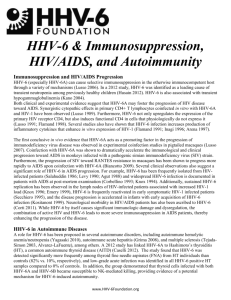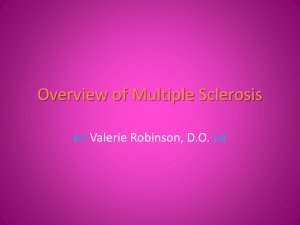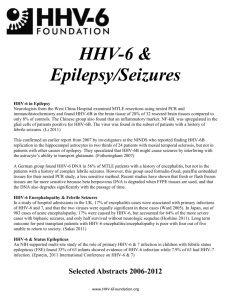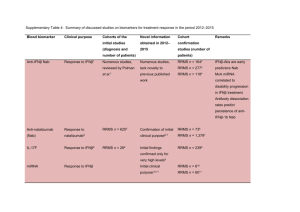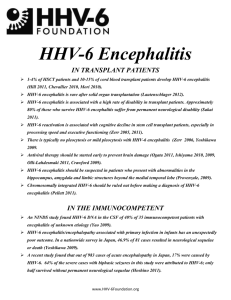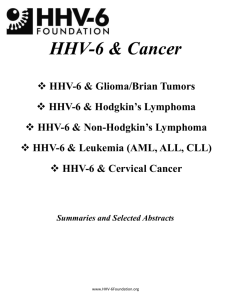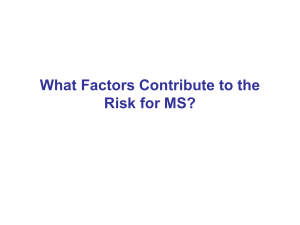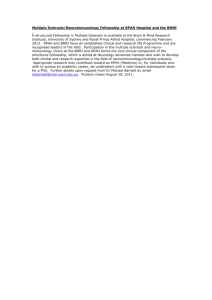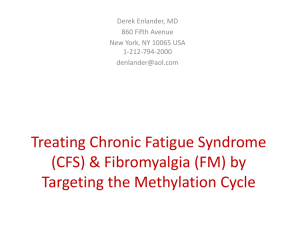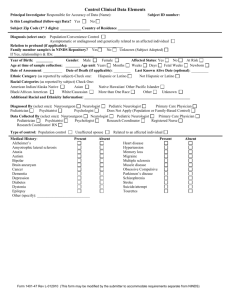Multiple Sclerosis - HHV
advertisement
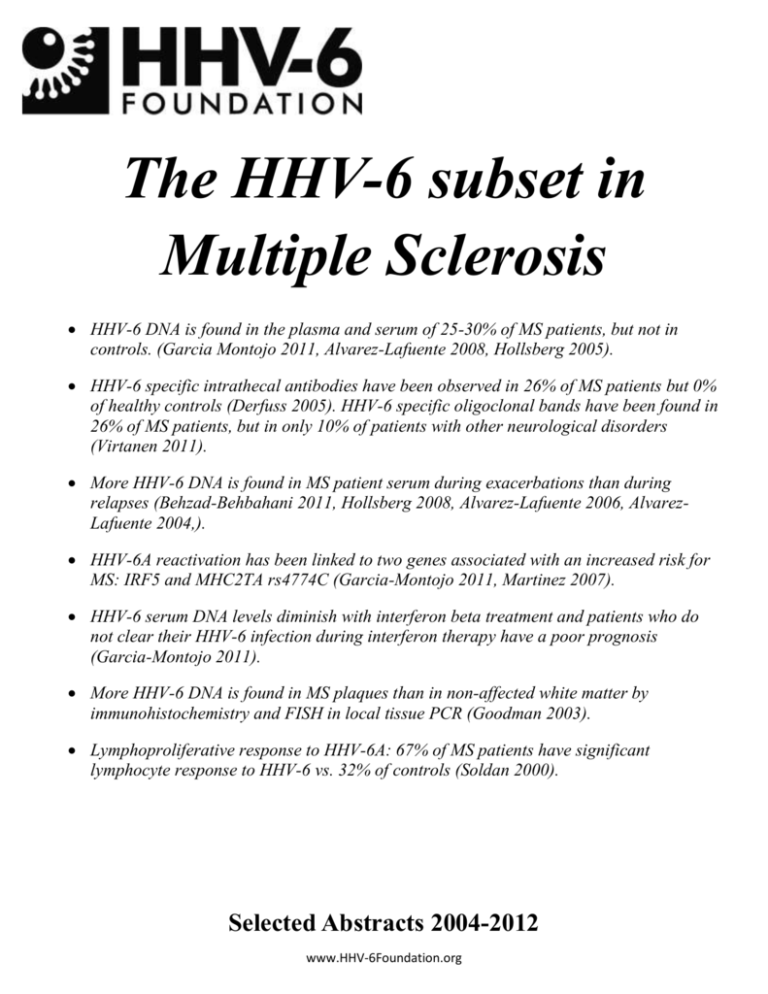
The HHV-6 subset in Multiple Sclerosis HHV-6 DNA is found in the plasma and serum of 25-30% of MS patients, but not in controls. (Garcia Montojo 2011, Alvarez-Lafuente 2008, Hollsberg 2005). HHV-6 specific intrathecal antibodies have been observed in 26% of MS patients but 0% of healthy controls (Derfuss 2005). HHV-6 specific oligoclonal bands have been found in 26% of MS patients, but in only 10% of patients with other neurological disorders (Virtanen 2011). More HHV-6 DNA is found in MS patient serum during exacerbations than during relapses (Behzad-Behbahani 2011, Hollsberg 2008, Alvarez-Lafuente 2006, AlvarezLafuente 2004,). HHV-6A reactivation has been linked to two genes associated with an increased risk for MS: IRF5 and MHC2TA rs4774C (Garcia-Montojo 2011, Martinez 2007). HHV-6 serum DNA levels diminish with interferon beta treatment and patients who do not clear their HHV-6 infection during interferon therapy have a poor prognosis (Garcia-Montojo 2011). More HHV-6 DNA is found in MS plaques than in non-affected white matter by immunohistochemistry and FISH in local tissue PCR (Goodman 2003). Lymphoproliferative response to HHV-6A: 67% of MS patients have significant lymphocyte response to HHV-6 vs. 32% of controls (Soldan 2000). Selected Abstracts 2004-2012 www.HHV-6Foundation.org HHV-6 & MS Intrathecal human herpesvirus 6 antibodies in multiple sclerosis and other demyelinating diseases presenting as oligoclonal bands in cerebrospinal fluid. Virtanen JO, Pietiläinen-Nicklén J, Uotila L, Färkkilä M, Vaheri A, Koskiniemi M. Department of Virology, Haartman Institute, University of Helsinki, Finland. J Neuroimmunol. 2011 Aug 15;237(1-2):93-7. Demyelinating diseases of the central nervous system (CNS) often include elevated IgG production in intrathecal space presenting as oligoclonal bands (OCBs) in cerebrospinal fluid (CSF). In most demyelinating diseases, e.g. in multiple sclerosis (MS), the underlying cause is not known. We used isoelectric focusing and affinity immunoblot to study the specificity of CSF OCBs to human herpesvirus-6 (HHV-6) in patients with demyelinating diseases of the CNS including MS. Eighty patients with positive OCB finding were included in the study. The OCBs reacted with the HHV-6 antigen in 18 cases (23%). Twelve of 46 MS patients (26%), 5 of 24 other demyelinating diseases (21%) and 1 of 10 other neurological disorders (10%) had HHV-6 specific OCBs in CSF. A specific intrathecal HHV-6 A and B antibody production was shown in a proportion of patients with demyelinating diseases and might suggest a role in the pathogenesis of these diseases. Human herpesvirus 6 and effectiveness of interferon beta 1b in multiple sclerosis patients. Garcia-Montojo M, De Las Heras V, Dominguez-Mozo M, Bartolome M, Garcia-Martinez MA, Arroyo R, Alvarez-Lafuente R; HHV-6 and Multiple Sclerosis Study Group. Unidad de Esclerosis Múltiple, Servicio de Neurología, Hospital Clínico San Carlos, Madrid, Spain. Eur J Neurol. 2011 Aug;18(8):1027-35. BACKGROUND: Human herpesvirus 6 (HHV-6) and Epstein-Barr virus (EBV) have been repeatedly associated with multiple sclerosis (MS) pathogenesis. Also, it has been speculated that, besides its immunomodulatory properties, the efficacy of interferon beta (IFN-beta) in treating the disease may be related to its antiviral properties. The objectives of this study were to evaluate the in vivo antiviral effect of IFN-beta-1b over HHV-6 and EBV and to analyze whether such effect could be involved in its effectiveness in MS. METHODS: A total of 54 patients with MS were included in an observational, multicentric, 24-month study. HHV-6 and EBV were detected by qPCR in blood and serum samples. IFN-beta-1b effectiveness was evaluated by presence, number and severity of relapses, reduction in the relapse rate, disability progression, and response to the treatment. RESULTS: Patients with HHV-6 in blood had a higher risk of severe relapses (P=0.01) and bad response (P=0.03). HHV-6 was detected more frequently during relapses than in remission in blood (P=0.024) and in serum (P=0.0002). Patients with HHV-6 in serum had more relapses (P=0.02), lesser reduction in the relapse rate (P=0.04), and a lower proportion of responders (P=0.02) than those without HHV-6 active replication. However, any association between EBV and clinical parameters could not be found. CONCLUSIONS: We concluded that presence of HHV-6 in blood and serum during IFN-beta treatment could be a good marker of poor response. Human herpesvirus 6 and 7 reactivation and disease activity in multiple sclerosis. Nora-Krukle Z, Chapenko S, Logina I, Millers A, Platkajis A, Murovska M. August Kirchenstein Institute of Microbiology and Virology, Riga Stradins University, Latvia. Medicina (Kaunas). 2011;47(10):527-31. Recent studies have focused on the associations between human herpesvirus 6 (HHV-6) and human herpesvirus 7 (HHV7), and multiple sclerosis (MS). The aim of this study was to investigate the associations between HHV-6 and HHV-7 reactivation and MS disease activity, and interleukin 12 (IL-12) and tumor necrosis factor α (TNF-α) production. www.HHV-6Foundation.org 2 HHV-6 & MS MATERIAL AND METHODS: The frequency of plasma viremia by nested polymerase chain reaction and transcription of viral mRNA in peripheral blood mononuclear cells by reverse transcriptase-polymerase chain reaction (RT-PCR) of 14 relapsing/remitting (RR) and 14 secondary progressive (SP) MS patients were studied in comparison with clinical manifestation of the disease. Serum concentrations of cytokines IL-12 and TNF-α were analyzed by enzyme-linked immunosorbent assay. RESULTS: Plasma samples from 25 of the 28 MS patients with estimated latent/persistent HHV-6 and/or HHV-7 infection were examined during relapse and remission/relative remission. HHV-6 reactivation was found in 4 of the 7 RRMS and 4 of the 7 SPMS patients, and HHV-7 reactivation was identified in 3 of the 7 RRMS and 1 of the 7 SPMS patients (all in relapse). In 2 of the 3 RRMS patients without viremia in relapse, HHV-6 mRNA transcription was detected. In RRMS and SPMS patients with active HHV-6 and HHV-7 infection in relapse, the serum concentrations of IL-12 and TNF-α were significantly higher than in those with latent virus infection. CONCLUSIONS: HHV-6 and HHV-7 reactivation could be implicated in the exacerbation of MS via activation of Th1 lymphocyte subsets. Validation of IRF5 as multiple sclerosis risk gene: putative role in interferon beta therapy and human herpes virus-6 infection. Vandenbroeck K, Alloza I, Swaminathan B, Antigüedad A, Otaegui D, Olascoaga J, Barcina MG, de las Heras V, Bartolomé M, Fernández-Arquero M, Arroyo R, Alvarez-Lafuente R, Cénit MC, Urcelay E. Neurogenomiks, University of the Basque Country (UPV/EHU), Leioa, Spain. Genes Immun. 2011 Jan;12(1):40-5. In recent reports, IRF5 polymorphisms showed significant association with multiple sclerosis (MS) susceptibility in three studied populations and Irf5-deficient mice exhibited an increased susceptibility to viral infection, linked to a significant decrease in the induction of serum type I interferon (IFN). In the present study, we evaluated the association of two IRF5 polymorphisms with MS predisposition and we also addressed whether these polymorphisms were associated with active replication of human herpes virus-6 (HHV-6) observed in a subgroup of MS patients, and/or with response to IFN-β therapy. A total of 1494 MS patients and 1506 ethnically matched controls were genotyped for rs4728142 and rs3807306 with TaqMan pre-designed assays. One hundred and six patients were classified as responders to IFN-β therapy (no relapses/increases in EDSS over the 2-year follow-up) and 112 as non-responders (at least two relapses or an increase in expanded disability status scale (EDSS) of at least one point during the same period). The combined analysis of available datasets yielded an effect size on MS with odds ratio (OR)(Mantel-Haenszel)=1.14 (P<0.002) for the IRF5 polymorphisms rs4728142 and rs3807306. Additionally, trends for association were observed between rs3807306T and infection with HHV-6 [p=0.05, OR (95% CI)=1.56 (1.00-2.44)] and response to IFN-β therapy [P=0.09, OR (95% CI)=1.39 (0.95-2.05)]. Human herpesvirus-6 viral load and antibody titer in serum samples of patients with multiple sclerosis. Behzad-Behbahani A, Mikaeili MH, Entezam M, Mojiri A, Pour GY, Arasteh MM, Rahsaz M, Banihashemi M, Khadang B, Moaddeb A, Nematollahi Z, Azarpira N. Medical Technology Research Center, Faculty of Para-Clinical Medicine, Shiraz University of Medical Sciences, Shiraz, Iran. J Microbiol Immunol Infect. 2011 Aug;44(4):247-51. BACKGROUND: Despite the number of cases with definite diagnosis of multiple sclerosis (MS) being on increase, the role of human herpesvirus-6 (HHV-6) infection as a trigger for MS disease still is deliberated. Based on antibody detection and quantitative HHV-6 polymerase chain reaction assay, this study was achieved to find out the possible association between infection with HHV-6 and clinical progression of MS disease. METHODS: www.HHV-6Foundation.org 3 HHV-6 & MS A total of 108 serum samples were obtained from 30 MS patients followed prospectively for a 6-month period. These samples were analyzed for the presence of HHV-6 DNA by nested polymerase chain reaction enzyme-linked immunosorbent assay and for anti-HHV-6 IgG titer. Activation of the disease was determined by either magnetic resonance imaging or by clinical status of the patients. Control groups were also included. RESULTS: The average antibody index for the MS patients in the first sample collection was higher than both control groups (p = 0.001). HHV-6 DNA was detected in the serum samples of 10 of 30 MS patients. The mean HHV-6 viral load in patients with relapsing-remitting multiple sclerosis (RRMS) with and without relapse was 973 and 714, respectively. Seven patients showed an exacerbation during the study period. Of those, four patients had HHV-6 DNA in their collected samples. The prevalence of HHV-6 DNA was significantly higher in patients with MS as compared with control groups (p = 0.001). CONCLUSIONS: The results indicate that HHV-6 is implicated somehow in MS disease. Over time, rising HHV-6 IgG antibody titers together with an exacerbation and detection of HHV-6 DNA in serum samples of some MS patients suggests possible association between the reactivation of the virus and disease progression. Herpesviruses and human endogenous retroviral sequences in the cerebrospinal fluid of multiple sclerosis patients. Alvarez-Lafuente R, García-Montojo M, De Las Heras V, Domínguez-Mozo MI, Bartolome M, Benito-Martin MS, Arroyo R. Servicio de Neurología, Hospital Clínico San Carlos, Madrid, Spain. Mult Scler. 2008 Jun;14(5):595-601. To analyze the possible role of human herpesvirus (HHVs) and human endogenous retroviruses (HERVs) infection in multiple sclerosis (MS) pathogenesis. METHODS: A total of 92 cerebrospinal fluid (CSF) samples were collected: 48 from MS patients at the first clinically evident demyelinating event, 23 from patients with other inflammatory neurological diseases (OINDs) and 21 from patients with other non-inflammatory neurological diseases (ONINDs). Total DNA and RNA were isolated, and the prevalences and viral loads of herpes simplex virus (HSV), varicella-zoster virus (VZV), Epstein-Barr virus (EBV), cytomegalovirus (CMV), HHV-6, HERV-H and HERV-W in the CSF of MS patients and controls were evaluated using a quantitative realtime polymerase chain reaction assay. RESULTS: (i) For HSV, 1/48 (2.1%, 86 copies/ml of CSF) MS patients and 1/23 (4.3%, 115.2 copies/ml of CSF) OIND patients (a myelitis case) had HSV sequences in the CSF; (ii) for EBV, only 1/48 (2.1%, 72 copies/ml of CSF) MS patients was positive for EBV; (iii) for HHV-6, only 5/48 (10.4%) MS patients had HHV-6 genomes in their CSF (128.1 copies/ml of CSF); (iv) we did not find any positive cases for VZV, CMV, HERV-H and HERV-W among MS patients or controls; (v) no cases of co-infections were found; (vi) the whole prevalence of HHVs was 7/48 (14.6%) for MS patients and 1/44 (2.3%) for controls (p = 0.038). CONCLUSION: The findings described here show that HHV infection is more frequent in the CSF of MS patients than in patients with other neurological diseases; however, only HHV-6 seems to be involved in the pathogenesis of MS in a subset of patients. Environment-gene interaction in multiple sclerosis: human herpesvirus 6 and MHC2TA. Martínez A, Alvarez-Lafuente R, Mas A, Bartolomé M, García-Montojo M, de Las Heras V, de la Concha EG, Arroyo R, Urcelay E. Clinical Immunology Department, Hospital Clínico San Carlos, Madrid, Spain. Hum Immunol. 2007 Aug;68(8):685-9. Multiple sclerosis (MS) is an inflammatory disorder affecting the central nervous system, in which both genetic and environmental factors interact. Among these environmental contributors, herpesvirus has been proposed as an important www.HHV-6Foundation.org 4 HHV-6 & MS etiologic factor. CIITA is a transcription factor controlling the expression of MHC class II genes, the main genetic determinants of MS susceptibility. This gene has been described as a target of the immunoevasive strategies, and it is therefore an attractive candidate gene to be at the genetic-viral crossroads. Two polymorphisms in MHC2TA gene (rs4,774G/C and rs3,087,456A/G) were studied in two groups: one in 22 multiple sclerosis patients with active human herpes virus 6 (HHV-6A) replication (HHV-6A-positive), and the other of 77 patients with no detectable HHV-6A active infection (HHV-6A-negative); a Spanish healthy control group (n = 520) was also included as external control. An association of the rs4,774C allele with the HHV-6A-positive group was found when compared with the HHV-6Anegative (47.7% vs 18.8%, p = 0.0001; odds ratio = 3.94) and also with the control group (47.7% vs 25.5%, p = 0.001, odds ratio = 2.67). No significant differences were observed between HHV-6A-negative subjects and healthy controls. Our data suggest that a strong gene-environment interaction occurs between HHV-6A active replication and MHC2TA rs4,774C or another polymorphism in tight linkage disequilibrium with it. Besides, this report indicates that when patients are grouped based upon a well-defined molecular event, complex diseases may reveal themselves as being constituted by distinct entities in which some genes may have a strong influence. Clinical parameters and HHV-6 active replication in relapsing-remitting multiple sclerosis patients. Alvarez-Lafuente R, García-Montojo M, De las Heras V, Bartolomé M, Arroyo R. Servicio de Neurología, Hospital Clínico San Carlos, Madrid, 28040, Spain. J Clin Virol. 2006 Dec;37 Suppl 1:S24-6. Although the etiology of multiple sclerosis (MS) remains uncertain, clinical, epidemiological, and laboratory findings suggest that environmental factors may be involved in the disease. OBJECTIVE: This study was undertaken in order to investigate the possible relation of human herpesvirus-6 (HHV-6) in relapsingremitting MS (RRMS). STUDY DESIGN: A one-year follow-up study was performed analyzing serum samples of 63 patients with RRMS and 63 healthy blood donors (HBD) by a quantitative real time PCR, to measure HHV-6 prevalence and viral load. Clinical data (starting age and EDSS increase) were collected. RESULTS: (i) We found 25.4% of RRMS patients with at least one positive serum sample along the one year follow-up. (ii) 19.1% of RRMS samples in relapse had HHV-6 active infection vs. 7.9% of RRMS samples in remission. (iii) We only found variant A. (iv) RRMS patients with HHV-6 active replication initiated the disease 1.9 years earlier, and they had a higher EDSS increase. CONCLUSIONS: A higher HHV-6A frequency of active infection seems to be related with the exacerbations in a subset of RRMS patients. Regarding the relationship between HHV-6A active infection and the clinical data in RRMS patients, further investigations are needed. Presence of Epstein–Barr virus and human herpesvirus 6B DNA in multiple sclerosis patients: associations with disease activity Hollsberg P, Kusk M, Bech E, Hansen HJ, Jakobsen J, Haahr S. Acta Neurol Scand 2005: 112: 395–402. Ó Blackwell Munksgaard 2005. Objective – To assess the presence of Epstein–Barr virus (EBV) and human herpesvirus 6B (HHV-6B) DNA in saliva and plasma from multiple sclerosis (MS) patients enrolled in a randomized, double- blind, placebo-controlled valacyclovir treatment study. Methods – DNA was prepared following ultracentrifugation of saliva and plasma. EBV and HHV-6B DNAs were determined by real-time polymerase chain reaction. Results – EBV and HHV-6B DNAs were detected in 41% and 65% of saliva samples, respectively. In patients treated www.HHV-6Foundation.org 5 HHV-6 & MS with valacyclovir, the percentage of saliva samples with EBV was significantly reduced (9%; P 1⁄4 0.000017), whereas the frequency of HHV-6B positive samples was unchanged (57%; P 1⁄4 0.38). Longitudinal studies demonstrated a timedependent reduction in the frequency of saliva samples containing EBV following valacyclovir treatment. In contrast, plasma contained EBV and HHV-6B DNAs in 17% and 25% of the samples, respectively, and these numbers were not significantly reduced following valacylovir treatment (13% and 16%, respectively), nor were they different from those of healthy controls (6% and 39%, respectively). Patients with high disease activity had a significantly higher frequency of EBV (P 1⁄4 0.018) and HHV-6B (P 1⁄4 0.023) positive samples than did patients with low disease activity. The presence of EBV and HHV-6B was strongly correlated in plasma (P < 0.00000001), but not in saliva (P 1⁄4 0.41). Conclusion – MS patients express EBV and HHV-6B in both saliva and plasma, but only the expression of EBV in saliva is significantly reduced following valacyclovir treatment. Although EBV and HHV-6B DNAs can be detected in plasma from healthy individuals, the co-expression of both these viruses in MS patients is highly significant and further associated with clinical activity. The observations of viral DNA in plasma are consistent with an underlying immunologic defect in MS. Relapsing-remitting multiple sclerosis and human herpesvirus 6 active infection. Alvarez-Lafuente R, De las Heras V, Bartolomé M, Picazo JJ, Arroyo R. Servicio de Neurología, Hospital Clínico San Carlos, 28040 Madrid, Spain. Arch Neurol. 2004 Oct;61(10):1523-7. BACKGROUND: Recent studies have focused on the relationship between human herpesvirus 6 (HHV-6) and multiple sclerosis (MS). OBJECTIVE: To analyze HHV-6 messenger RNA expression in patients with relapsing-remitting (RR) MS vs healthy blood donors (HBDs). DESIGN: One hundred fifty-four subjects were enrolled in the study: 105 patients with RRMS (32 in relapse) and 49 HBDs. Total DNA and messenger RNA were extracted from serum and blood samples, respectively, and analyzed by quantitative realtime reverse transcription-polymerase chain reaction for the detection of 3 HHV-6 immediate-early genes (U16/U17,U89/U90, and U94) and both HHV-6 variants (HHV-6A and HHV-6B). RESULTS: Active HHV-6 infection was detected in 16% of patients with RRMS vs 0% of HBDs (P = .003). Seven patients with RRMS with exacerbation had HHV-6 active replication, and the virus remained latent in only 1 of them. We did not find any statistically significant difference between HHV-6 active or latent infection for patients in remission (P = .12). Among patients with RRMS with HHV-6 active replication, viral load was higher when they experienced an acute attack than when in remission (P = .04). In those patients with RRMS who had an active infection only, HHV-6A was found. Cell-free HHV-6 DNA detected in serum samples confirmed the results. CONCLUSIONS: The results show that a subset of patients with RRMS experience HHV-6 active infection, and there likely is an association between the viral active replication and relapses; therefore, HHV-6 active infection may imply a greater risk of exacerbations in a subgroup of patients with RRMS. www.HHV-6Foundation.org 6
